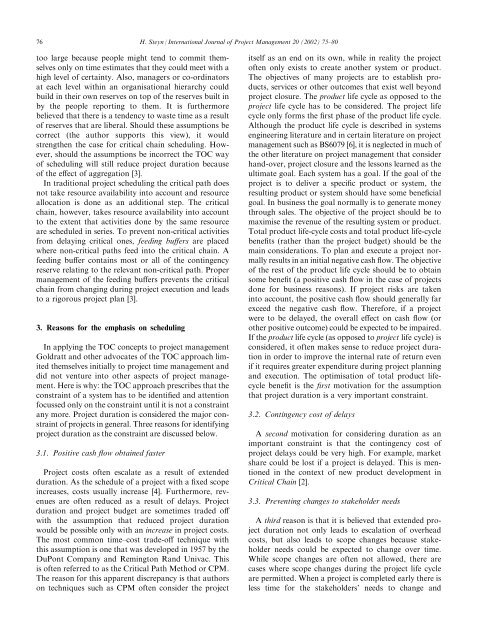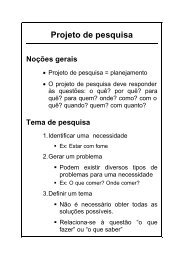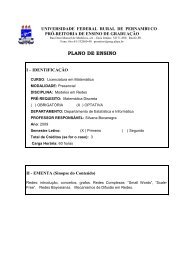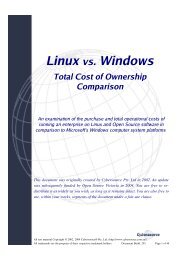Project management applications of the theory of constraints beyond ...
Project management applications of the theory of constraints beyond ...
Project management applications of the theory of constraints beyond ...
Create successful ePaper yourself
Turn your PDF publications into a flip-book with our unique Google optimized e-Paper software.
76 H. Steyn / International Journal <strong>of</strong> <strong>Project</strong> Management 20 2002) 75±80too large because people might tend to commit <strong>the</strong>mselvesonly on time estimates that <strong>the</strong>y could meet with ahigh level <strong>of</strong> certainty. Also, managers or co-ordinatorsat each level within an organisational hierarchy couldbuild in <strong>the</strong>ir own reserves on top <strong>of</strong> <strong>the</strong> reserves built inby <strong>the</strong> people reporting to <strong>the</strong>m. It is fur<strong>the</strong>rmorebelieved that <strong>the</strong>re is a tendency to waste time as a result<strong>of</strong> reserves that are liberal. Should <strong>the</strong>se assumptions becorrect <strong>the</strong> author supports this view), it wouldstreng<strong>the</strong>n <strong>the</strong> case for critical chain scheduling. However,should <strong>the</strong> assumptions be incorrect <strong>the</strong> TOC way<strong>of</strong> scheduling will still reduce project duration because<strong>of</strong> <strong>the</strong> e€ect <strong>of</strong> aggregation [3].In traditional project scheduling <strong>the</strong> critical path doesnot take resource availability into account and resourceallocation is done as an additional step. The criticalchain, however, takes resource availability into accountto <strong>the</strong> extent that activities done by <strong>the</strong> same resourceare scheduled in series. To prevent non-critical activitiesfrom delaying critical ones, feeding bu€ers are placedwhere non-critical paths feed into <strong>the</strong> critical chain. Afeeding bu€er contains most or all <strong>of</strong> <strong>the</strong> contingencyreserve relating to <strong>the</strong> relevant non-critical path. Proper<strong>management</strong> <strong>of</strong> <strong>the</strong> feeding bu€ers prevents <strong>the</strong> criticalchain from changing during project execution and leadsto a rigorous project plan [3].3. Reasons for <strong>the</strong> emphasis on schedulingIn applying <strong>the</strong> TOC concepts to project <strong>management</strong>Goldratt and o<strong>the</strong>r advocates <strong>of</strong> <strong>the</strong> TOC approach limited<strong>the</strong>mselves initially to project time <strong>management</strong> anddid not venture into o<strong>the</strong>r aspects <strong>of</strong> project <strong>management</strong>.Here is why: <strong>the</strong> TOC approach prescribes that <strong>the</strong>constraint <strong>of</strong> a system has to be identi®ed and attentionfocussed only on <strong>the</strong> constraint until it is not a constraintany more. <strong>Project</strong> duration is considered <strong>the</strong> major constraint<strong>of</strong> projects in general. Three reasons for identifyingproject duration as <strong>the</strong> constraint are discussed below.3.1. Positive cash ¯owobtained faster<strong>Project</strong> costs <strong>of</strong>ten escalate as a result <strong>of</strong> extendedduration. As <strong>the</strong> schedule <strong>of</strong> a project with a ®xed scopeincreases, costs usually increase [4]. Fur<strong>the</strong>rmore, revenuesare <strong>of</strong>ten reduced as a result <strong>of</strong> delays. <strong>Project</strong>duration and project budget are sometimes traded o€with <strong>the</strong> assumption that reduced project durationwould be possible only with an increase in project costs.The most common time±cost trade-o€ technique withthis assumption is one that was developed in 1957 by <strong>the</strong>DuPont Company and Remington Rand Univac. Thisis <strong>of</strong>ten referred to as <strong>the</strong> Critical Path Method or CPM.The reason for this apparent discrepancy is that authorson techniques such as CPM <strong>of</strong>ten consider <strong>the</strong> projectitself as an end on its own, while in reality <strong>the</strong> project<strong>of</strong>ten only exists to create ano<strong>the</strong>r system or product.The objectives <strong>of</strong> many projects are to establish products,services or o<strong>the</strong>r outcomes that exist well <strong>beyond</strong>project closure. The product life cycle as opposed to <strong>the</strong>project life cycle has to be considered. The project lifecycle only forms <strong>the</strong> ®rst phase <strong>of</strong> <strong>the</strong> product life cycle.Although <strong>the</strong> product life cycle is described in systemsengineering literature and in certain literature on project<strong>management</strong> such as BS6079 [6], it is neglected in much <strong>of</strong><strong>the</strong> o<strong>the</strong>r literature on project <strong>management</strong> that considerhand-over, project closure and <strong>the</strong> lessons learned as <strong>the</strong>ultimate goal. Each system has a goal. If <strong>the</strong> goal <strong>of</strong> <strong>the</strong>project is to deliver a speci®c product or system, <strong>the</strong>resulting product or system should have some bene®cialgoal. In business <strong>the</strong> goal normally is to generate moneythrough sales. The objective <strong>of</strong> <strong>the</strong> project should be tomaximise <strong>the</strong> revenue <strong>of</strong> <strong>the</strong> resulting system or product.Total product life-cycle costs and total product life-cyclebene®ts ra<strong>the</strong>r than <strong>the</strong> project budget) should be <strong>the</strong>main considerations. To plan and execute a project normallyresults in an initial negative cash ¯ow. The objective<strong>of</strong> <strong>the</strong> rest <strong>of</strong> <strong>the</strong> product life cycle should be to obtainsome bene®t a positive cash ¯ow in <strong>the</strong> case <strong>of</strong> projectsdone for business reasons). If project risks are takeninto account, <strong>the</strong> positive cash ¯ow should generally farexceed <strong>the</strong> negative cash ¯ow. Therefore, if a projectwere to be delayed, <strong>the</strong> overall e€ect on cash ¯ow oro<strong>the</strong>r positive outcome) could be expected to be impaired.If <strong>the</strong> product life cycle as opposed to project life cycle) isconsidered, it <strong>of</strong>ten makes sense to reduce project durationin order to improve <strong>the</strong> internal rate <strong>of</strong> return evenif it requires greater expenditure during project planningand execution. The optimisation <strong>of</strong> total product lifecyclebene®t is <strong>the</strong> ®rst motivation for <strong>the</strong> assumptionthat project duration is a very important constraint.3.2. Contingency cost <strong>of</strong> delaysA second motivation for considering duration as animportant constraint is that <strong>the</strong> contingency cost <strong>of</strong>project delays could be very high. For example, marketshare could be lost if a project is delayed. This is mentionedin <strong>the</strong> context <strong>of</strong> new product development inCritical Chain [2].3.3. Preventing changes to stakeholder needsA third reason is that it is believed that extended projectduration not only leads to escalation <strong>of</strong> overheadcosts, but also leads to scope changes because stakeholderneeds could be expected to change over time.While scope changes are <strong>of</strong>ten not allowed, <strong>the</strong>re arecases where scope changes during <strong>the</strong> project life cycleare permitted. When a project is completed early <strong>the</strong>re isless time for <strong>the</strong> stakeholders' needs to change and
















